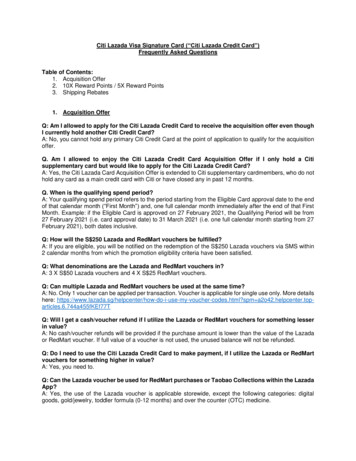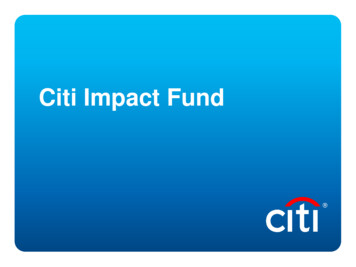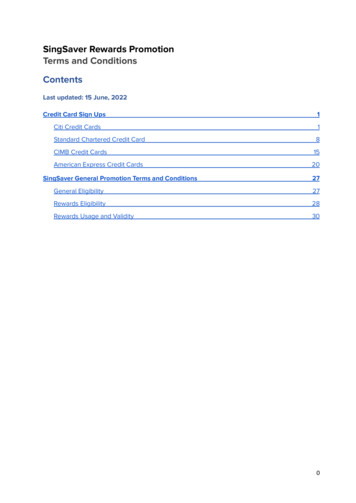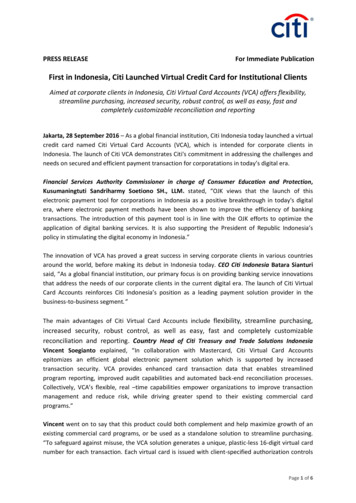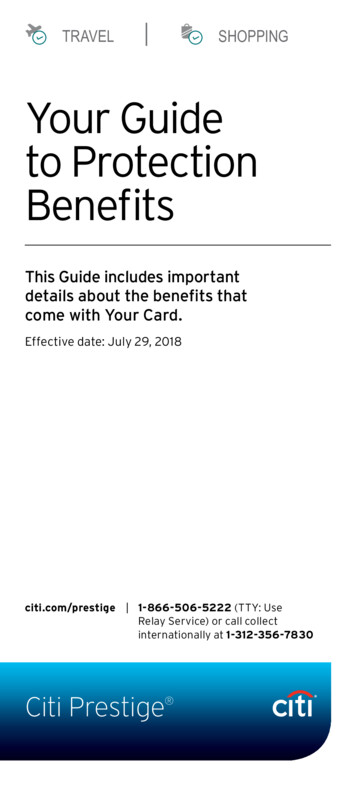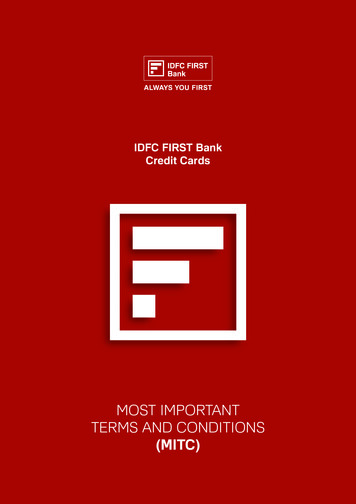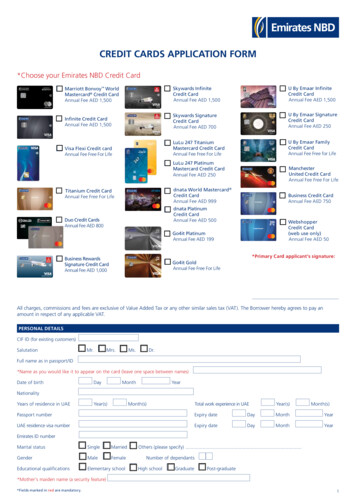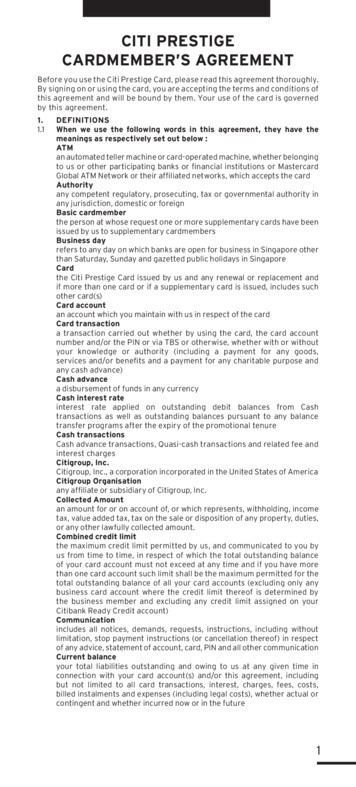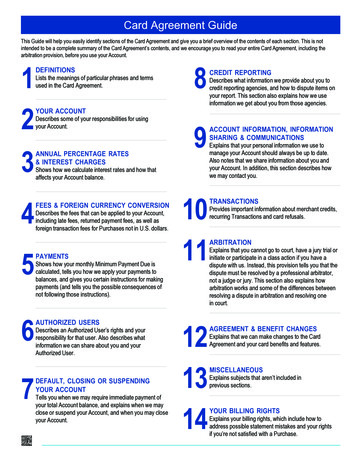
Transcription
Card Agreement GuideThis Guide will help you easily identify sections of the Card Agreement and give you a brief overview of the contents of each section. This is notintended to be a complete summary of the Card Agreement’s contents, and we encourage you to read your entire Card Agreement, including thearbitration provision, before you use your Account.1234567DEFINITIONSLists the meanings of particular phrases and termsused in the Card Agreement.YOUR ACCOUNTDescribes some of your responsibilities for usingyour Account.ANNUAL PERCENTAGE RATES& INTEREST CHARGES89Shows how we calculate interest rates and how thataffects your Account balance.FEES & FOREIGN CURRENCY CONVERSIONDescribes the fees that can be applied to your Account,including late fees, returned payment fees, as well asforeign transaction fees for Purchases not in U.S. dollars.PAYMENTSShows how your monthly Minimum Payment Due iscalculated, tells you how we apply your payments tobalances, and gives you certain instructions for makingpayments (and tells you the possible consequences ofnot following those instructions).AUTHORIZED USERSDescribes an Authorized User’s rights and yourresponsibility for that user. Also describes whatinformation we can share about you and yourAuthorized User.DEFAULT, CLOSING OR SUSPENDINGYOUR ACCOUNTTells you when we may require immediate payment ofyour total Account balance, and explains when we mayclose or suspend your Account, and when you may closeyour Account.1011121314CREDIT REPORTINGDescribes what information we provide about you tocredit reporting agencies, and how to dispute items onyour report. This section also explains how we useinformation we get about you from those agencies.ACCOUNT INFORMATION, INFORMATIONSHARING & COMMUNICATIONSExplains that your personal information we use tomanage your Account should always be up to date.Also notes that we share information about you andyour Account. In addition, this section describes howwe may contact you.TRANSACTIONSProvides important information about merchant credits,recurring Transactions and card refusals.ARBITRATIONExplains that you cannot go to court, have a jury trial orinitiate or participate in a class action if you have adispute with us. Instead, this provision tells you that thedispute must be resolved by a professional arbitrator,not a judge or jury. This section also explains howarbitration works and some of the differences betweenresolving a dispute in arbitration and resolving onein court.AGREEMENT & BENEFIT CHANGESExplains that we can make changes to the CardAgreement and your card benefits and features.MISCELLANEOUSExplains subjects that aren’t included inprevious sections.YOUR BILLING RIGHTSExplains your billing rights, which include how toaddress possible statement mistakes and your rightsif you’re not satisfied with a Purchase.
Card AgreementThis Card Agreement (Agreement) is your contract with us.The Facts about Interest and Fees document (Fact Sheet) is part of this Agreement. The Fact Sheet shows important information about your Account,such as your annual percentage rates and certain fees. Any amendments to this Agreement also are part of this Agreement.Please read all parts of this Agreement, including the arbitration provision, and keep it for your records.Note: Throughout the Agreement are examples, helpful tips and additional explanationsthat will make the Agreement easier to understand.1DEFINITIONSAccount – Your Citi Account.Adjusted New Balance – Your New Balance less any Citi Flex Planbalance.Annual Percentage Rate (APR) – A rate, shown as a percentage, usedto calculate interest on the balance on your Account.Authorized User – Any person you allow to use your Account with aCard we provided with that person’s name.Balance Transfer – Use of a Balance Transfer offer, including use of acheck that accesses your Account for any transaction, or the transfer ofa balance from another credit account to your Account.Billing Period – The period of time between each date when we createa statement for your Account. A Billing Period is usually 28 – 33 days.For each Billing Period, your statement will show any Transactions, othercharges, payments and other credits posted during that Billing Period.Business Day – Monday through Friday, excluding federal holidays.Card – One or more cards or other devices (including an accountnumber) used to access your Account to obtain credit.Card Networks – Organizations, such as Mastercard, Visa andAmerican Express, that facilitate the payment process between acardmember, merchants and a card issuer.Cash Advance – Use of your Card to get cash, including foreigncurrency, or for what we consider a cash-like transaction. Examplesinclude using your Card for: ATM and teller withdrawals, wire transfers,money orders, traveler’s checks, lottery tickets, gaming chips and othermethods used for gambling, wagers and other betting transactions.A Citi Flex Loan is not a Cash Advance.Citi Flex Loan – Funds provided to you by check or by direct depositthat you select to be charged to your Account and repaid under a CitiFlex Plan. Balance Transfers and Cash Advances are not Citi FlexLoans.Citi Flex Pay – Eligible Transactions that you select to be paid under aCiti Flex Plan.Citi Flex Plan – A feature on your Account to pay Citi Flex Loans or CitiFlex Pay amounts in fixed payments over a defined number of BillingPeriods subject to a Citi Flex Plan APR.Consumer Reporting Agency – An organization, such as Experian,Equifax and TransUnion, that compiles credit information for the purposeof generating consumer credit reports. It’s also known as a “creditbureau” and a “credit reporting agency.”Include and including – These terms mean “include [or including]without limitation.”Late Payment – A payment is late if you don’t pay at least an amountequal to the Minimum Payment Due minus any Overlimit Amount by thepayment due date.New Balance – The total amount you owe us at the end of each BillingPeriod. This amount is shown on each statement under the heading“New Balance.” We explain how we calculate the New Balance below.Overlimit Amount – The amount by which your Account balanceexceeds your credit limit in any Billing Period.Purchase – Use of your Card to buy goods and services. BalanceTransfers and Cash Advances are not Purchases.Returned Payment – A payment that isn’t honored by yourfinancial institution.Transaction – A Balance Transfer, Cash Advance, Purchase orCiti Flex Plan, as applicable.we, us and our – Citibank, N.A.you and your – The cardmember who opened the Account.You’ll find definitions of other terms within this Agreement.1
2YOUR ACCOUNTYour Account use is subject to this Agreement. You must pay us forall amounts due on your Account, including:Citi Flex Plan. Your ability to create a Citi Flex Plan will depend on theamount of your available credit, creditworthiness, and other factors. Wemay limit the number of active Citi Flex Plans you can have and we maychange this number at any time. There are two ways to create a Citi FlexPlan – Citi Flex Pay and Citi Flex Loan.1. Transactions you make, even if you didn’t present your Card or signfor the Transaction;2. Transactions an Authorized User makes;With Citi Flex Pay, you can pay for eligible Transactions under a CitiFlex Plan. An eligible Transaction for Citi Flex Pay must be a Purchase ofat least a specified dollar amount and does not include a Purchase ofcash or cash equivalent, a Purchase subject to Foreign Transaction Feesor any fee owed to us. Other exclusions may apply.3. Transactions that other people make if you or an Authorized User letthem use your Account; and4. Any fees and interest charges on the Account.Binding Agreement. This Agreement takes effect once you use yourCard. Even if you don’t use your Card, this Agreement will take effectunless you contact us to cancel your Account within 30 days after wesent you this Agreement.With Citi Flex Loan, you can use your Account’s credit line to accessfunds and pay such funds under a Citi Flex Plan. You can only create aCiti Flex Loan if you receive an offer. The offer will tell you the terms,including the APR, that will apply to that Citi Flex Loan.Credit Limit. We assign a credit limit to your Account. Part of this creditlimit may be available for Cash Advances, and there may be a limit onthe amount of Cash Advances you can take in a given period. Wemay authorize Transactions that cause your balance to exceed yourcredit limit.Unlawful Transactions. You aren’t permitted to use your Account forunlawful Transactions. If you do use your Account for unlawfulTransactions, this Agreement still applies and you must pay us for thoseTransactions. You also may have to pay the Card Network and/or us forany damages and expenses resulting from that use. In addition, we mayclose your Account.ACCOUNT USEMobile Phone or Other Devices. Smart phones, tablets and otherelectronic devices can store your Card (such as through a mobile wallet).This means they can be used to make Purchases or other Transactions.Any such Transactions are covered by this Agreement. Apps that useyour Card to make Transactions may have separate terms of use. We’renot responsible if you violate those terms, or for any consequencesresulting from any violation.Consumer Purposes. You aren’t permitted to use your Account forbusiness purposes. If you do use your Account for business purposes,this Agreement still applies, and you must pay us for those Transactions.You have to pay us for any damages and/or expenses resulting from thatuse. In addition, we may also close your Account.Note: It’s important to protect your devices the same way you protect your Card.Anyone who can access your Card using your device also can make charges to your Account using that device.3ANNUAL PERCENTAGE RATES & INTEREST CHARGESThe following sections explain how we calculate the interest youowe each Billing Period.APRs. We use APRs to calculate interest charges on your Account.Different APRs may apply to different Transactions. See the listing of yourAPRs on the Fact Sheet.Variable APRs. A variable APR is an APR that can change each BillingPeriod. We calculate each variable APR first by taking the U.S. PrimeRate from The Wall Street Journal (WSJ) two Business Days before thelast day of each Billing Period. (If the WSJ doesn’t publish the U.S. PrimeRate that day, then we’ll use another publication.) Then we add to theU.S. Prime Rate a certain percentage amount, which we call the Margin.You can find the Margin we use for your Account in the Details AboutYour Interest Rate section of the Fact Sheet. Your variable APRs willincrease if the U.S. Prime Rate increases and decrease if the U.S. PrimeRate decreases. If a variable APR increases, then your interest chargesand Minimum Payment Due may increase.How is a variable APR calculated?If the U.S. Prime Rate published in the WSJ two Business Daysbefore the end of a Billing Period is 5%; andIf the Margin is 13.99%; thenAdd the two together to calculate a variable APR:5% 13.99% 18.99%If the U.S. Prime Rate changes, we’ll apply the new variable APR startingfrom the first day of the Billing Period when we take the U.S. Prime Ratefrom the WSJ. The new APR will apply to existing balances, as well asbalances added to your Account after the change.Penalty APR. If you have a Late or a Returned Payment, we may applya penalty APR to your Account. We determine your penalty APR basedon your creditworthiness.continued on next page2
Section 3 — ANNUAL PERCENTAGE RATES & INTEREST CHARGES (continued) Penalty APR for new Transactions (less than 60 days late).If you make a Late Payment and it’s less than 60 days late or youhave a Returned Payment, the penalty APR only will apply to newTransactions. We’ll review your Account from time to time, todetermine if any penalty APR should be reduced. Penalty APR for existing balances and new Transactions (60 ormore days late). If we haven’t received your Minimum Payment Duewithin 60 days after its due date, we may apply the penalty APR toboth the existing balances and new Transactions. If you make yournext 6 consecutive Minimum Payments Due on time, we’ll stopapplying the penalty APR to existing balances and new Transactions.If you don’t make your next 6 consecutive Minimum Payments Due ontime, the penalty APR may continue to apply indefinitely to existingbalances and new Transactions.Daily BalanceWe calculate interest on your Account each Billing Period first bycalculating your daily balances. The following explains how we do that.Here’s how and when Transactions, fees and credits are applied tothe balances on your Account: We add the amount of a Purchase or Balance Transfer to thePurchase balance as of the post date on your statement. We add the amount of a Cash Advance to the Cash Advance balanceas of the post date on your statement. We add a Balance Transfer fee to the Purchase balance as of the postdate on your statement. We add the amount of any eligible Transaction under Citi Flex Pay or aCiti Flex Loan to a Citi Flex Plan balance as of the post date on yourstatement. If you moved an amount from another balance within yourAccount to a Citi Flex Plan, we will credit the other balance in theamount you added to a Citi Flex Plan in order to avoid double countingthat amount. We add a Cash Advance fee to the Cash Advance balance as of thepost date on your statement. We’ll add any other fees to the balanceof our choice. If you’re charged interest in a Billing Period, but theamount calculated is less than 0.50, we’ll add additional interest tothe balance(s) of our choice so that you’ll be charged 0.50 in interestfor that Billing Period. We subtract credits and payments as of the post date shown onyour statement. Each balance may have a different APR. Certain categories ofTransactions in a balance may have multiple APRs. For example, youmay make a Purchase or Balance Transfer, or create a Citi Flex Plan,that’s subject to a promotional APR. Your balances, and theircorresponding APRs, are shown on your statement.Note: The post date shown on your statement will usually be the dateof the Transaction, but it may be later.Here’s how we calculate each of the daily Purchase, Cash Advanceand Citi Flex Plan balances on your Account: We start with the daily balance from the end of the previous day. We add any new Transactions, fees and other charges, includinginterest accrued on the previous day’s balance. This means thatinterest is compounded daily. We subtract any credits or payments credited as of that day. We make additional adjustments as appropriate, subject toapplicable law (as an example, for a disputed charge). This gives usthe daily balance for that day.Daily balance for purchases from the previous day New purchases Fees and interest accrued on the previous day’s Purchasebalance– Payments, credits and adjustments posted that day New daily balance for PurchasesInterest Calculation. Each daily balance may have a different APR.Certain categories of Transactions in a daily balance may have multipleAPRs. For example, you may make a Purchase or Balance Transferthat’s subject to a promotional APR. If a daily balance on your Accountis subject to an APR, we’ll charge interest on that daily balance. Weuse the daily balance method (which includes new Transactions). Ifinterest applies to a balance, it will start applying on the day a charge isadded to that balance and continue until that balance is paid in full. Weconsider a credit balance as a balance of zero when calculatinginterest on that balance. We multiply each daily balance by its applicable daily periodic rates(each applicable APR divided by 365). We do this for each day in the Billing Period. This gives us the dailyinterest amounts. Then we total all the daily interest amounts for all the daily balances.This gives us the total interest for the Billing Period.Note: Your balances, and their corresponding APRs, are shown onyour statement.Calculating the New Balance. To calculate the New Balance at theend of each Billing Period, we begin with the total Account balance atthe start of that Billing Period. Then we add any Transactions that arenew to the Account during that Billing Period. Then we subtract anycredits applied or payments made during that Billing Period. Then weadd any interest charges or fees incurred during that Billing Period andmake any other adjustments, as applicable (for example, if you havedisputed a charge).Grace Period on Purchases. You won’t pay any interest onPurchases if you pay the Adjusted New Balance, including any BalanceTransfers, plus any Citi Flex Plan Payment Amount, in full by thepayment due date shown on your statement each Billing Period. Wecall this a grace period on purchases. If you don’t pay your AdjustedNew Balance in full, plus any Citi Flex Plan Payment Amount, by thepayment due date in a Billing Period, you’ll pay interest on yourPurchases from the date they’re posted to your Account. You alsowon’t have a grace period on Purchases again until you pay theAdjusted New Balance in full, plus any Citi Flex Plan Payment Amount,by the payment due date 2 Billing Periods in a row.There’s no grace period on Balance Transfers and Cash Advances.This means you’ll pay interest on Balance Transfers and CashAdvances from the date these Transactions post to your Account.continued on next page3
Section 3 — ANNUAL PERCENTAGE RATES & INTEREST CHARGES (continued)Important Information about Citi Flex Plans: We apply anyamount you pay over your Minimum Payment Due first to the balancewith the highest APR, then to the balance with the next highest APR,and so on, as described in Section 5, Application of Payments. Thismeans that, if the APR for a Citi Flex Plan balance is higher than anAPR that applies to another balance on your Account, we will applythe amount you pay above the Minimum Payment Due to that CitiFlex Plan balance prior to that other balance. This will cause you topay off that Citi Flex Plan balance before the end of its repaymentperiod and may result in an amount remaining due on your nextbilling statement for the other balance, increasing your Adjusted NewBalance on your next billing statement.You can see your balances and their corresponding APRs on yourstatement.For example, in a sample Billing Period, an Account with no pastdue or Overlimit Amounts, has:Citi Flex Plan: 5,000 with a repayment period of 24 months at16.99% APRCiti Flex Plan statement balance in sample Billing Period: 4,090The New Balance for the Account: is 9,090. The Adjusted NewBalance is the New Balance ( 9,090) less the Citi Flex PlanBalance ( 4,090): 5,000. Your Minimum Payment Due is 323( 75 248). To retain your grace period on purchases, you mustpay the Adjusted New Balance ( 5,000) plus your Citi Flex PlanPayment Amount ( 248): 5,248.If your Purchase APR is equal to or higher than your Citi Flex PlanAPR and you make a payment to retain your grace period onpurchases ( 5,248), your Purchase balance will be reduced to 0.This means that, to retain your grace period on purchases in thenext Billing Period, you will be required to pay 248 (your Citi FlexPlan Payment Amount), assuming you do not make any newTransactions.Grace Period for Citi Flex Plan balances. When you create a CitiFlex Plan, you will be charged interest on the Citi Flex Plan balancefrom the start of the Billing Period following the Billing Period whenyou created the Citi Flex Plan. This means that you will not becharged interest on the Citi Flex Plan balance during the BillingPeriod in which you created the Citi Flex Plan.Citi Flex Plan interest charge in sample Billing Period: 56.92Citi Flex Plan Payment Amount per Billing Period: 248andPurchase balance: 5,000Minimum Payment Due for Purchases: 75(Calculations are approximate and for illustrative purposes only.)4
4FEES & FOREIGN CURRENCY CONVERSIONFEESFeeAmountAbout the FeeAnnual Membership FeeSee Pricing TableIf your Account has an annual membership fee, the Fact Sheet shows this fee.You’ll see this annual fee on your first statement after opening your Account andeach year after that. We’ll charge the fee if your Account is open, even if youdon’t have a balance.Late FeeUp to 40We have the right to charge you a late fee if you don’t pay at least an amountequal to the Minimum Payment Due minus any Overlimit Amount by the paymentdue date. The late fee is 29 and, if you make another Late Payment within thenext 6 Billing Periods the late fee will be 40. The amount of your late fee willnever be higher than your Minimum Payment Due.Returned Payment FeeUp to 40We have the right to charge you a Returned Payment fee of 29 if your bankdoesn’t honor your payment. If that happens, we’ll resubmit the payment request.If your bank doesn’t honor another payment within 6 consecutive Billing Periods,the returned payment fee will go up to 40.Transaction Fee forBalance TransfersEither 5 or 3% of the amount ofeach transfer, whichever is greater.We charge you a fee for each Balance Transfer.Transaction Fee forCash AdvancesEither 10 or 5% of the amount of eachcash advance, whichever is greater.We charge you a fee for each Cash Advance.FOREIGN CURRENCY CONVERSIONForeign Currency Conversion – Purchases. A Card Network converts theamount of a Purchase in a foreign currency into U.S. dollars. Each Card Networkfollows its own procedures for conversion. These procedures include how theCard Network chooses an exchange rate and when to do the conversion. Forexample, Visa chooses either a government-mandated exchange rate orchooses from a range of rates available on wholesale currency markets (and,in either case, the exchange rate that it chooses may be less favorable thanthe rate that Visa itself, receives when it makes foreign currency transactions).Depending on the policies of each Card Network, the exchange rate chosenmay be the one in effect on the day the Card Network does the conversion, oron the day before. The exchange rate that a Card Network uses to convert thePurchase to U.S. dollars may differ from the rate in effect on the date you madethe Purchase or on the post date for that Purchase shown on your statement.The Card Network’s procedures may change without notice.If a third party, such as a merchant, converts the amount of a Purchase into U.S.dollars before sending the Purchase to a Card Network, the third party choosesthe conversion rate instead of the Card Network.Foreign Currency Conversion – Cash Advances. If you take a CashAdvance in a foreign currency at an ATM or branch of a financialinstitution, it may not be the Card Network in all instances that convertsthe Transaction into U.S. dollars. Instead, depending on where theTransaction takes place, another third party, such as a financialinstitution, ATM network or ATM operator, may do the conversion. We donot control this. However, if you use your Card for a Cash Advance at aCitibank ATM or branch, then we or our affiliates may do the conversion.The party that converts a Cash Advance to U.S. dollars will choose theexchange rate and when to do the conversion. The exchange rate ineffect on the date the Cash Advance is converted to U.S. dollars maydiffer from the rate in effect on the date you took the Cash Advance orthe post date for that Transaction shown on your statement. Theexchange rate may also differ from any rate quoted to you when youmade the Transaction.5
5PAYMENTSMinimum Payment Due. You may pay all or a part of your Accountbalance at any time. You must pay at least the Minimum Payment Due bythe payment due date each Billing Period.Your “Minimum Payment Due” equals: Any amount past due; plus Any Overlimit Amount; plus Any Citi Flex Plan Payment Amount; plus The greater of:1. The Adjusted New Balance, if it’s less than 35;2. 35 if the Adjusted New Balance is at least 35;3. 1% of the Adjusted New Balance (rounded to the nearest dollar),plus any billed interest or minimum interest charge, plus any latefee; or4. 1.5% of the Adjusted New Balance (rounded to the nearest dollar).The Minimum Payment Due is never more than the New Balance.Note: Your payment due date is typically the same day of the month everymonth. You may request a change to your monthly due date. The number of months in the Citi Flex Plan repayment period. We then round the result up to the nearest dollar.The formula we use for determining the amount described directlyabove is: The Citi Flex Plan balance, multiplied by (IPAPR / 12 ) / (1-(1 IPAPR / 12 ) -N), rounded up to the nearestdollar. “IPAPR” equals the specific Citi Flex Plan APR applicable to theCiti Flex Plan balance. “N” equals the number of months in the Citi FlexPlan repayment period.The actual interest charged on your Plan will be calculated as describedin Section 3. Your first Citi Flex Plan Payment Amount will be due in theBilling Period following the Billing Period in which you created the Citi FlexPlan. If you do not pay your Minimum Payment Due in full by the duedate, you may owe additional interest on your Citi Flex Plan balance. Thiswill not increase the Citi Flex Plan Payment Amount for subsequent BillingPeriods, but you may be required to make additional payments after theend of the Citi Flex Plan repayment period to pay your Citi Flex Planbalance (including any additional interest) in full.New Balance: 2,500Interest: 18.54If you have not paid your Minimum Payment Due for any three BillingPeriods during the Citi Flex Plan, and the Minimum Payment Due forthose three Billing Periods remains outstanding at the end of your currentBilling Period, we may cancel any existing Citi Flex Plan from yourAccount, then add the balance of any canceled Citi Flex Plan to thePurchase balance, retaining the Citi Flex Plan APR that was in effect attime of cancellation. We may also do this if:Since the New Balance is more than 35, and there are no past due orOverlimit amounts, the Minimum Payment Due will be the greater of: You file for bankruptcy or some other insolvencyproceeding is filed by or against you.1% of the New Balance(1.0% x 2,500: 25.00) interest ( 18.54): 43.54or1.5% of the New Balance (1.5% x 2,500): 37.50 You don’t honor the terms of this Agreement.How is the Minimum Payment Due calculated?For example, in a sample Billing Period, an Account with no past due,Overlimit or Citi Flex Plan Payment amount has:Since 1% of the New Balance plus interest ( 43.54) is greater than1.5% of the New Balance ( 37.50) the Minimum Payment Due is 43.54.Citi Flex Plan Payment Amount. The Minimum Payment Due will includeany amount due on a Citi Flex Plan balance each Billing Period (the “CitiFlex Plan Payment Amount”). You must pay the Citi Flex Plan PaymentAmount each Billing Period, calculated as described below, for so long asany balance remains in the Citi Flex Plan. The Citi Flex Plan PaymentAmount will never be more than the amount of the Citi Flex Plan balance.We determine the Citi Flex Plan Payment Amount for each Citi Flex Planthat you will pay in each Billing Period as follows: The Citi Flex Plan balance as of the date you create the Citi Flex Plan,plus The estimated interest charges for the Citi Flex Plan calculated on thedaily balance from the start of the next Billing Period following theBilling Period in which you created the Citi Flex Plan through the end ofthe Citi Flex Plan repayment period (assuming that you pay theMinimum Payment Due on your Account each month on the due date),the sum of which is divided by: You’re declared incompetent or mentally incapacitated or inthe event of your death. You enter into a hardship assistance program.If any of the above events occur, we will calculate the Minimum PaymentDue as part of the Adjusted New Balance as described in Section 5 andyou will no longer pay a monthly Citi Flex Plan Payment Amount. Anycanceled Citi Flex Plan balance amount that was added to a Purchasebalance will not be added back to a Citi Flex Plan balance, even if youpay your outstanding Minimum Payment Due in full. You will not beeligible to create another Citi Flex Plan until you pay your outstandingMinimum Payment Due in full, and then only if we offer you theopportunity to create another Citi Flex Plan.Important Information about Citi Flex Plans and Promotional APRs:If your Citi Flex Plan APR is higher than any other APR, such as apromotional Balance Transfer APR, we will apply any payment you makeabove the Minimum Payment Due to that Citi Flex Plan balance prior tothe lower APR balances. This means that if you want to pay off abalance with a lower promotional APR before the promotional periodexpires, you must first pay off all your other balances with higherAPRs, including your Citi Flex Plan balance, before you can pay offthat promotional balance.continued on next page6
Section 5 — PAYMENTS (continued)For example, in a sample Billing Period, an Account with no past dueor Overlimit Amounts, has:Citi Flex Plan: 5,000 with a repayment period of 24 months at16.99% APRCiti Flex Plan statement balance in sample Billing Period: 4,090Citi Flex Plan interest charge in sample Billing Period: 56.92Citi Flex Plan Payment Amount per Billing Period: 248AndBalance Transfer amount: 3,500Balance Transfer promotional APR: 0.00% (increases to standardPurchase APR of 19.99% after the promotion period ends in thenext Billing Period)Application of Payments. We decide how to apply your payment, upto the Minimum Payment Due, to the balances on your Account. Wemay apply the Minimum Payment Due first to interest charges, then tothe balance with the lowest APR and then to balances with higherAPRs. If you pay more than the Minimum Payment Due, we’ll apply theamount over the Minimum Payment Due first to the balance with thehighest APR, then to the balance with the next highest APR, and so on,except as otherwise required by applicable law.Payment Instructions. You must follow the instructions below whenmaking a payment. I
A Citi Flex Loan is not a Cash Advance. Citi Flex Loan - Funds provided to you by check or by direct deposit that you select to be charged to your Account and repaid under a Citi Flex Plan. Balance Transfers and Cash Advances are not Citi Flex Loans. Citi Flex Pay - Eligible Transactions that you select to be paid under a Citi Flex Plan.
